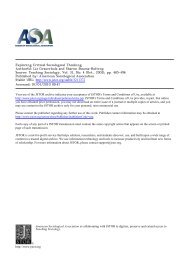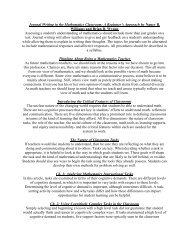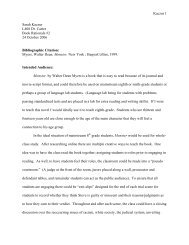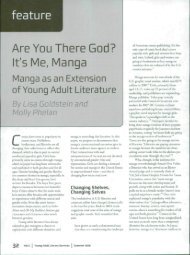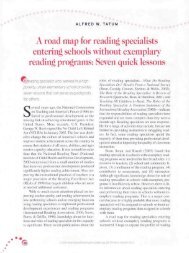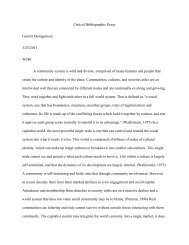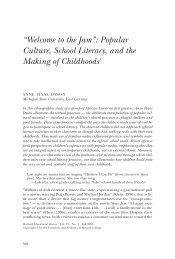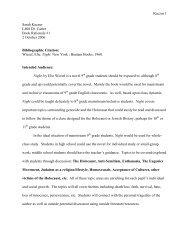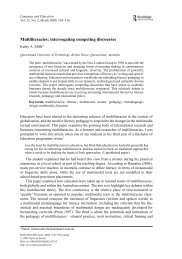McDonald 2004 Critical Reading 10-11 year olds.pdf - Oncourse
McDonald 2004 Critical Reading 10-11 year olds.pdf - Oncourse
McDonald 2004 Critical Reading 10-11 year olds.pdf - Oncourse
Create successful ePaper yourself
Turn your PDF publications into a flip-book with our unique Google optimized e-Paper software.
24 Moving from reader response to critical reading<br />
141T<br />
Sonya, I want to ask – do you have grandparents<br />
who are like that? Is that your experience?<br />
[S nods assent].Yeh. They are actually,<br />
they are not all like that, it is unfortunate that<br />
you have had that experience. (Lesson 15)<br />
In this talk the students reflected on how their own<br />
experience of the elderly aligns itself with what the<br />
novel offered. The students’ talk blurred lived experience<br />
and textual experience and implied a recognition<br />
that multiple positions were available for elderly<br />
women. The students were able to consider the ways<br />
of being taken up by their own female relatives and to<br />
recognise the shifting roles that this may entail. Thus<br />
Sonya’s resistance revealed the dynamic quality of<br />
knowledge in constructing the potential for alternative<br />
subject positions. Here, in effect, the student moved<br />
towards a critical reading, which questioned the reader<br />
and subject positions offered in the teacher’s metatextual<br />
talk. What is apparent in these exchanges is that by<br />
making an alternative discourse available for debate<br />
the teacher positioned the students to examine their<br />
experiences in the light of that alternative.<br />
Conclusion<br />
This article has presented an analysis of aspects of four<br />
different lessons that utilised features of narrative and<br />
feminist qualities of the study text to move students<br />
towards critical reading. The lesson analysis elaborated<br />
on how an analytical/critical reading contrasted<br />
with a response reading developed through students’<br />
stories. <strong>Reading</strong> positions alternative to those established<br />
in non-critical talk emerged as the students<br />
began to observe the construction of characterisation<br />
and aspects of different gender discourses.<br />
The power of the novel to ‘pull’ a reader into alignment<br />
with its characters and ideology is important to note.<br />
Deliberately developing this alignment also appears to<br />
be essential for students’ motivation and interest. What<br />
is also apparent from the transcripts is the contribution<br />
that deliberation on points-of-view, the conflation of<br />
personal understandings with narrative analysis, and<br />
involvement in ‘debates’ makes to readers’ enjoyment<br />
and enthusiasm. The potential to utilise a response<br />
reading position in order to develop a critical reading<br />
position with literary texts is implied.<br />
The selection of the novel is crucial to supporting<br />
moves towards critical reading. The features of the<br />
novel’s construction offered the teacher a resource to<br />
introduce her readers to the possibility of alternative<br />
ways of being. The students’ interpretative responses<br />
to a gender discourse were deliberately positioned<br />
within a focus question ‘frame’, which both structured<br />
a comparison of characteristics and constructed a<br />
move towards a recognition of a particular gendered<br />
position. Thus the focus question could be seen to mark<br />
a point on a response-critical continuum, where it<br />
invited responses to character analysis and also highlighted<br />
alternative ways of being for females.<br />
Lastly, it is interesting to observe that the authorised<br />
classroom talk promoted a reading position which<br />
complied with the novel’s ideology. Nevertheless,<br />
debates emerged when one student engaged in a<br />
critique of the discourse position presented in the<br />
novel and in the metatextual talk. Thus the literary text<br />
offered the possibility of an inspection of certain ways<br />
of being and thinking, where lived experience could be<br />
examined and tested in the light of vicarious fictional<br />
experience. Furthermore, perhaps for the participants,<br />
and certainly for such analysis as this, the student<br />
challenge revealed the process by which critical reading<br />
may be attained.<br />
References<br />
AUSTRALIAN COUNCIL OF EDUCATIONAL RESEARCH (1986)<br />
Progressive Achievement Test in <strong>Reading</strong>. Hawthorne: ACER.<br />
BAKER, C. (1991a) <strong>Reading</strong> the texts of reading lessons. Australian<br />
Journal of <strong>Reading</strong>, 14.1, pp. 5–20.<br />
BAKER, C. (1991b) ‘Literacy Practices and Social Relations in<br />
Classroom <strong>Reading</strong> Events’ in Baker, C. and Luke, A. (eds) Towards<br />
a <strong>Critical</strong> Sociology of <strong>Reading</strong> Pedagogy. Amsterdam/Philadelphia:<br />
John Benjamins.<br />
BAKER, C. (1992) Description and analysis in classroom talk and<br />
interaction. Journal of Classroom Interaction, 27.2, pp. 9–14.<br />
BAKER, C. (1997) ‘Literacy Practices and Social Order’ in Muspratt,<br />
S., Luke, A. and Freebody, P. (eds) Constructing <strong>Critical</strong> Literacies.<br />
Sydney: Allen & Unwin pp. 243–272.<br />
BAKER, C. and FREEBODY, P. (1989a) ‘Talk Around Text: Constructions<br />
of Textual and Teacher Authority in Classroom Discourse’ in<br />
de Castell, S., Luke, A. and Luke, C. (eds) Language, Authority and<br />
Criticism: <strong>Reading</strong>s on the School Textbook. London: The Falmer<br />
Press, pp. 263–283.<br />
BAKER, C. and FREEBODY, P. (1989b) Children’s First School Books.<br />
Oxford: Basil Blackwell.<br />
BAYNHAM, M. (1995) Literacy Practices Investigating Literacy in Social<br />
Contexts. London: Longman.<br />
BRADFORD, C. (ed.) (1996) Writing the Australian Child. Nedlands:<br />
University of Western Australia Press in association with Deakin<br />
University: Centre for Research in Cultural Communication.<br />
CANDLIN, C. (1992) ‘General Editor’s Preface’ in Stephens, J. (ed.)<br />
Language and Ideology in Children’s Fiction. London and New York:<br />
Longman, pp. vii–ix.<br />
FISH, S. (1979) Interpreting the ‘Variorum’. <strong>Critical</strong> Inquiry, 2, pp. 478–<br />
485.<br />
FREEBODY, P. (1991) ‘Inventing Cultural-capitalist Distinctions in<br />
the Assessment of HSC Papers: Coping with Inflation in an Era of<br />
‘‘Literacy Crisis’’’ in Christie, F. (ed.) Literacy in Social Processes.<br />
Papers from the Inaugural Australian Systemic Functional<br />
Linguistics Conference, Deakin University, January 1990. Darwin:<br />
Centre for Studies of Language in Education, Northern Territory<br />
University, pp. 96–<strong>10</strong>8.<br />
FRENCH, F. (1986) Snow White in New York. Oxford: Oxford<br />
University Press.<br />
GEE, J. (1996) Social Linguistics and Literacies: Ideology in Discourses,<br />
(2nd edn). London: The Falmer Press.<br />
GLEESON, L. (1987) I am Susannah. North Ryde: Angus & Robertson.<br />
ISER, W. (1978) The Act of <strong>Reading</strong>: A Theory of Aesthetic Response.<br />
Baltimore: John Hopkins University Press.<br />
KEMPE, A. (1993) No single meaning: empowering students to<br />
construct socially critical readings of the text. Australian Journal of<br />
Language and Literacy, 16.4, pp. 307–322.<br />
LUKE, A. and FREEBODY, P. (1997) ‘Shaping the Social Practices of<br />
<strong>Reading</strong>’ in Muspratt, S., Luke, A. and Freebody, P. (eds)<br />
r UKLA 2003



